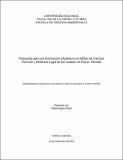| dc.contributor.author | Reyes Pérez, Paola | |
| dc.date.accessioned | 2017-04-27T15:19:30Z | |
| dc.date.available | 2017-04-27T15:19:30Z | |
| dc.date.created | 2017-04-27 | |
| dc.date.issued | 2016 | |
| dc.identifier.citation | Reyes-Pérez, P. (2016). Propuesta para una iluminación eficiente en el edificio de Ciencias Forenses y Medicina Legal de San Joaquín de Flores, Heredia. (Tesis de Licenciatura en Gestión Ambiental). Universidad Nacional | es_ES |
| dc.identifier.uri | http://hdl.handle.net/11056/13663 | |
| dc.description.abstract | Se realizó un estudio de iluminación en las luminarias del edificio de Ciencias Forense y
Medicina Legal del OIJ, donde se determinó la capacidad luminosa bajo la norma INTE 31-
08-06 2014, donde se diagnosticó el nivel de iluminación en el edificio según la actividad
de labor que se realiza. En el inventario de lámparas, se encontró la mayor parte
fluorescentes tubulares de tipo T12 y T8 de la marca Sylvania y Philips.
La etapa de medición se inició en diciembre del 2013 y concluyó en julio del 2014, en este
lapso se realizó el inventario de lámparas del edificio para poder determinar el consumo
energético en iluminación en el edificio, la calidad energética de las luminarias de algunas
habitaciones, así como los niveles de iluminación de los espacios estudiados en la
edificación. Todas estas mediciones se tomaron en cuenta las distintas áreas de la
infraestructura, a excepción de las bodegas de indicios y archivos de casos especiales
debido al reglamento de la institución.
Los resultados más relevantes durante el estudio fueron, los departamentos de Clínica
Médico Forense de Medicina Forense y Bioquímica de Ciencias Forense del OIJ. Estos
departamentos tienen un consumo energético correspondiente en iluminación, de un valor
aproximado 30,000.00 kWh/año en la Clínica y valor 25,000.00 kWh/año en Bioquímica de
un consumo anual aproximado 80,000.00 kWh/año. Esto presentan un 37.5% del consumo
anual para la Clínica y un 31.3% de consumo anual para Bioquímica, significando que
requieren el uso de las iluminación artificial durante sus tareas.
De igual manera, estos dos departamentos emiten CO2 equivalente por año con un valor
aproximado a un 39% en Clínica Médico Forense y de un 32% en Bioquímica, debido al
uso constante de la iluminación representan el mayor porcentaje en el edificio. El mismo
caso, con el ocurre con la emisiones potenciales de mercurio, donde los dos departamentos
tienen un valor aproximado de 5000 mg de Hg. | es_ES |
| dc.description.abstract | A lighting study was carried out in the luminaires of the Forensic Sciences building and
Legal Medicine of the OIJ, where the luminous capacity was determined under the INTE 31-
08-06 2014, where the lighting level in the building was diagnosed according to activity
of work being done. In the inventory of lamps, most of the
Tubular fluorescent type T12 and T8 from Sylvania and Philips.
The measurement stage began in December 2013 and concluded in July 2014, in this
The building's lamp inventory was carried out in order to determine consumption
energy in lighting in the building, the energy quality of the luminaires of some
rooms, as well as the lighting levels of the spaces studied in the
edification. All these measurements were taken into account the different areas of the
infrastructure, an exception of the evidence warehouses and special case files
due to the regulations of the institution.
The most relevant results during the study were, the departments of Clinic
Forensic Doctor of Forensic Medicine and Biochemistry of Forensic Sciences of the OIJ. These
the departments have a corresponding energy consumption in lighting, of a value
approximate 30,000.00 kWh / year in the Clinic and value 25,000.00 kWh / year in Biochemistry of
an approximate annual consumption of 80,000.00 kWh / year. This represents 37.5% of consumption
annual for the Clinic and a 31.3% annual consumption for Biochemistry, meaning that
requires the use of artificial lighting during their tasks.
Similarly, these two departments emit CO2 equivalent per year with a value
Approximately 39% in the Forensic Medical Clinic and 32% in Biochemistry, due to the
Constant use of lighting represents the largest percentage in the building. the same
This is the case with potential mercury emissions, where the two departments
they have an approximate value of 5000 mg of Hg. | |
| dc.language.iso | es | es_ES |
| dc.publisher | Universidad Nacional (Costa Rica). Escuela de Ciencias Agrarias | es_ES |
| dc.rights | Acceso abierto | |
| dc.rights.uri | http://creativecommons.org/licenses/by-nc-nd/4.0/ | |
| dc.subject | MANEJO AMBIENTAL | es_ES |
| dc.subject | ILUMINACIÓN | es_ES |
| dc.subject | POLÍTICA AMBIENTAL | es_ES |
| dc.subject | POLÍTICA ENERGÉTICA | es_ES |
| dc.subject | ELECTRICIDAD | es_ES |
| dc.subject | LUZ | es_ES |
| dc.subject | EFICIENCIA | es_ES |
| dc.title | Propuesta para una iluminación eficiente en el edificio de Ciencias Forenses y Medicina Legal de San Joaquín de Flores, Heredia | es_ES |
| dc.type | http://purl.org/coar/resource_type/c_7a1f | es_ES |
| bk-old-una.tipo | Licenciatura en Gestión Ambiental | es_ES |
| una.tesis.numero | Tesis 9423 | es_ES |


